The Qatar World Cup will be South Korea’s 10th consecutive appearance in the major competition.
Led by Paulo Bento, former Portugal and Sporting CP head coach, the team had a strong squad that could surprise everyone if the conditions were met.
In the last World Cup, South Korea was unable to qualify from the group because of the “miracle of Kazan.”
They lost the first two games but managed to beat Germany in the third game.
Mexico lost to Sweden, and the team stayed third in the group.
This year they are in Group H, where their opponents will be Ghana, Portugal, and Uruguay.
his tactical analysis will go over their tactics, using data and analysis to preview Dalić’s squad.
Finally, at the end of the scout report, we’ll give you our prediction for their World Cup run.
South Korea Predicted Starting XI
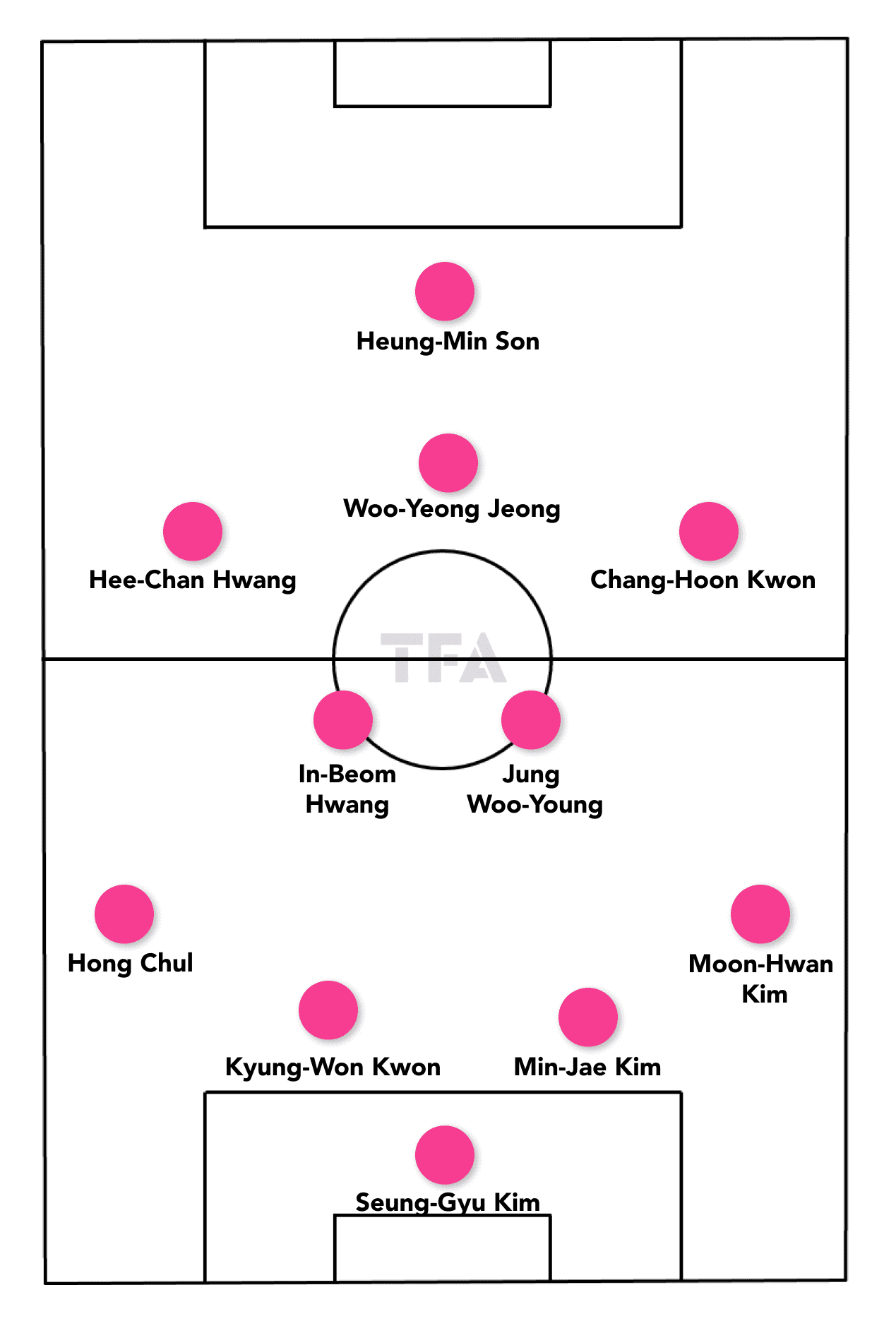
Recently, South Korea has also played with a 4-4-2 formation, but considering the personnel available, we believe they might go for a 4-2-3-1.
Because of the World Cup, Bento should be more reserved about getting one more player in midfield, having more flexibility to switch between the two.
But we do not entirely rule out the chance they come with a back five if they feel Portugal and Uruguay are much stronger opponents — they could do that with a winger dropping deep to help the defenders.
From the defence to the attack, South Korea have good players from top European leagues.
Centrally in the last line, Min-jae Kim is highly rated thanks to his performances at Napoli, where he has shown great ball-playing and defensive techniques.
His performance will be crucial to the defence.
In midfield, they have Olympiacos’ In-beom Hwang available, but we should not overlook Woo-young Jung, playing for Al Saad and who’s experienced the coaching of Xavi and Juanma Lillo as a holding midfielder.
Jung Woo-Young should also have the experience to drive the team in different phases of play.
South Korea have many good attacking players, including the Premier League duo Heung-min Son (Tottenham) and Hee-chan Hwang (Wolves).
Mallorca attacker Kang-in Lee and Freiburg striker Ui-jo Hwang could also help the team when needed.
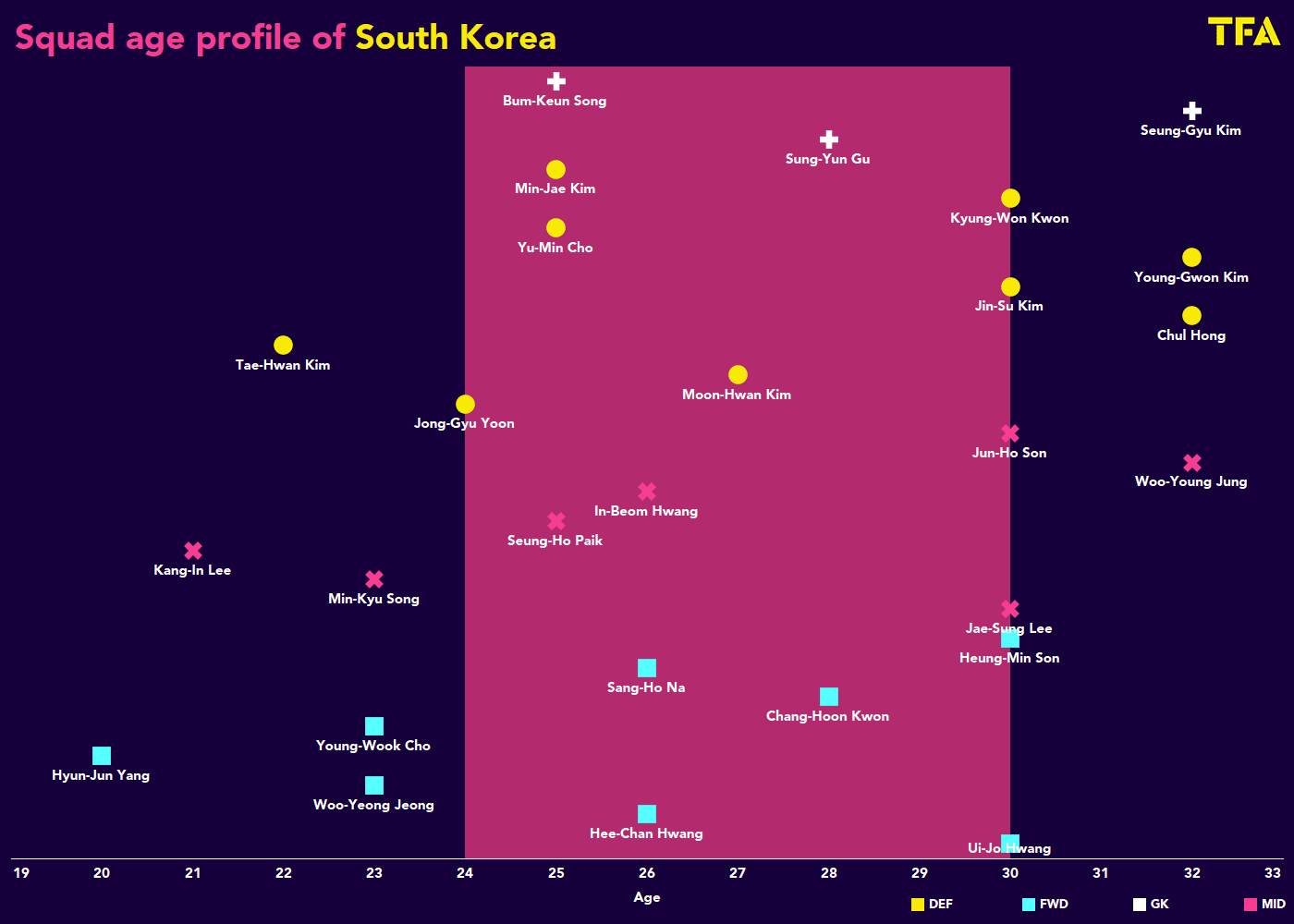
As the trend of South Korea’s squad age profile shows, the country has a very mature squad.
Most of the key players are in their peak age range, including the centre-back partnership between Jae Kim and Kyung-won Kwan.
At 30, star attacker Heung-min Son will definitely be motivated to achieve something for his country at this stage of his career.
South Korea Attacking phase
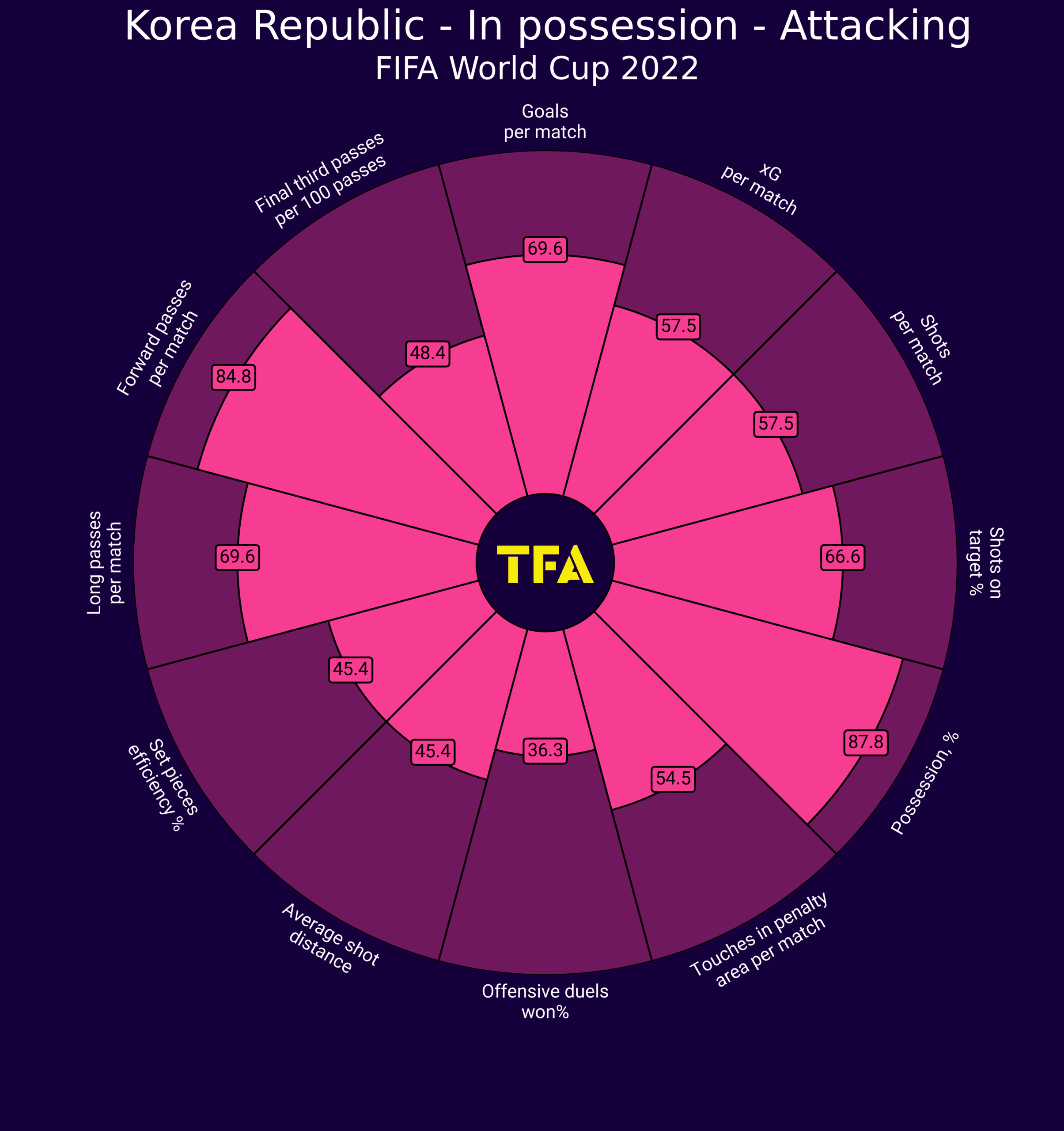
We can form a good picture of South Korea’s playing style from this chart.
Clearly, they try to play on the front foot with a strong mindset to breach the opposition lines, as their percentile rank of 84.8 in forward passes per match indicates.
They are fairly direct and try to hit spaces behind the opponent if possible with a high long pass per match percentile at 69.6.
They also have above-average xG and shots per match — both 57.5 — suggesting they’re able to create plenty of chances.
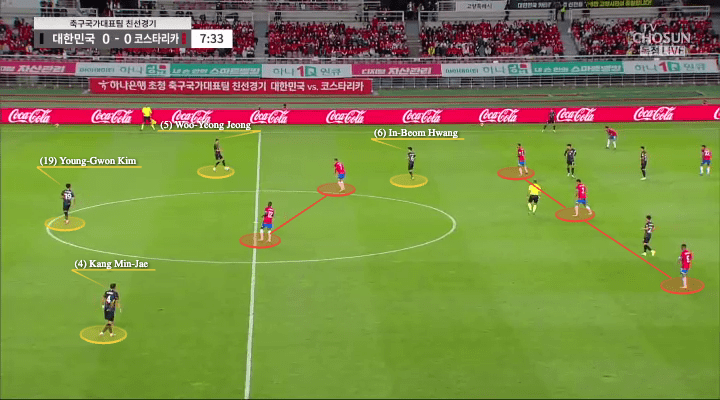
With the ball, South Korea always construct with four deep players.
They consistently push the full-backs high and wide to occupy the outside zones, so they also have two sixes to support in front of the centre-backs.
The shape can vary.
Apart from the 2-2 shape, the team also tends to drop one midfielder out, forming a 3-1.
As shown in this image, on the left of Min-jae Kang and Young-gwon Kim, South Korea used the midfielder, Woo-yeong Jeong dropping out to receive, so they had a temporary back three with In-beom Hwang behind the opposition’s first line.
With this shape, they always create a +1 numerical advantage over the two-man first line, such as Costa Rica’s 5-3-2, allowing the wide centre-backs to carry the ball forward.
because the opposition strikers could be pulled out of position, and the forward space in front of centre-backs could be vacated.
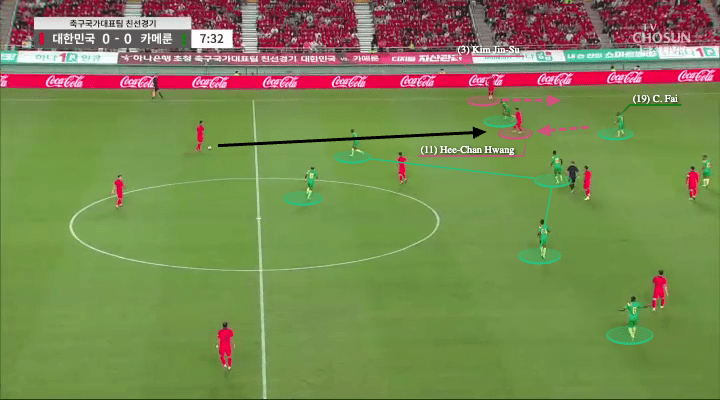
South Korea is a very aggressive side. They always have players preparing for runs behind the last line to catch the defenders out.
Direct passes over the top trigger potential chances against the goalkeeper centrally or 1v1 opportunities against the full-backs in outside space.
These kinds of actions always engage defenders and keep their heads busy worrying about spaces behind, creating the foundations for exploiting spaces between the lines when the defenders drop off too early to handle the runners in advance.
Therefore, in the second phase, with an open shape, South Korea also placed players in central spaces.
With the high and wide full-backs, the wingers can roam infield to receive in central positions, receiving on the half-turn, if possible.
Here, we see their shape pinned down the Cameroon winger, causing confusion as Hee-chan Hwang came infield when Jin-su Kim went forward.
It also created a temporary 2v1 overload on the right back.
The receiver would be possible to turn if the right-back prepared himself to catch the release pass to Jin-su Kim.
Apart from structurally driving the team forward, Bento also allowed Heung-min Son some freedom as a wild card.
The Tottenham Hotspur attacker could pick up the ball in the deeper area similar to Lionel Messi’s role, to work on his stuff and also combine with teammates in close proximity to go into advanced areas.
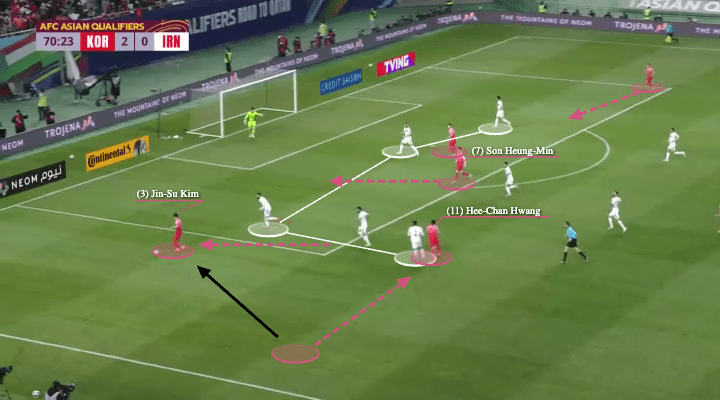
So far, in the last third, we have seen a South Korean team very willing to commit numbers into the penalty zone to create goalscoring opportunities.
They benefit from the structure in which full-backs go high and wide to be the crossing outlets and allow the attacking players, such as Heung-min Son, to get into good positions.
In this image, you can see the winger released the left-back, and now Jin-su Kim is ready for a cross.
At least South Korea would have both strikers (or a 10), plus the far-side winger in the box.
Another very noticeable player was Hee-chan Hwang, who immediately dashed into a more central position after playing the pass from out wide.
This position brought him closer to the opposition goal and gave him a better chance to score.
That means South Korea would love to have three to four players attacking the penalty zone — at least.
By getting lots of bodies in the box, they have a better chance of making first contact and scoring.
They’ve also scored some rebound opportunities previously, as they had enough numbers in the box to get onto the end of the second balls.
South Korea Defensive phase
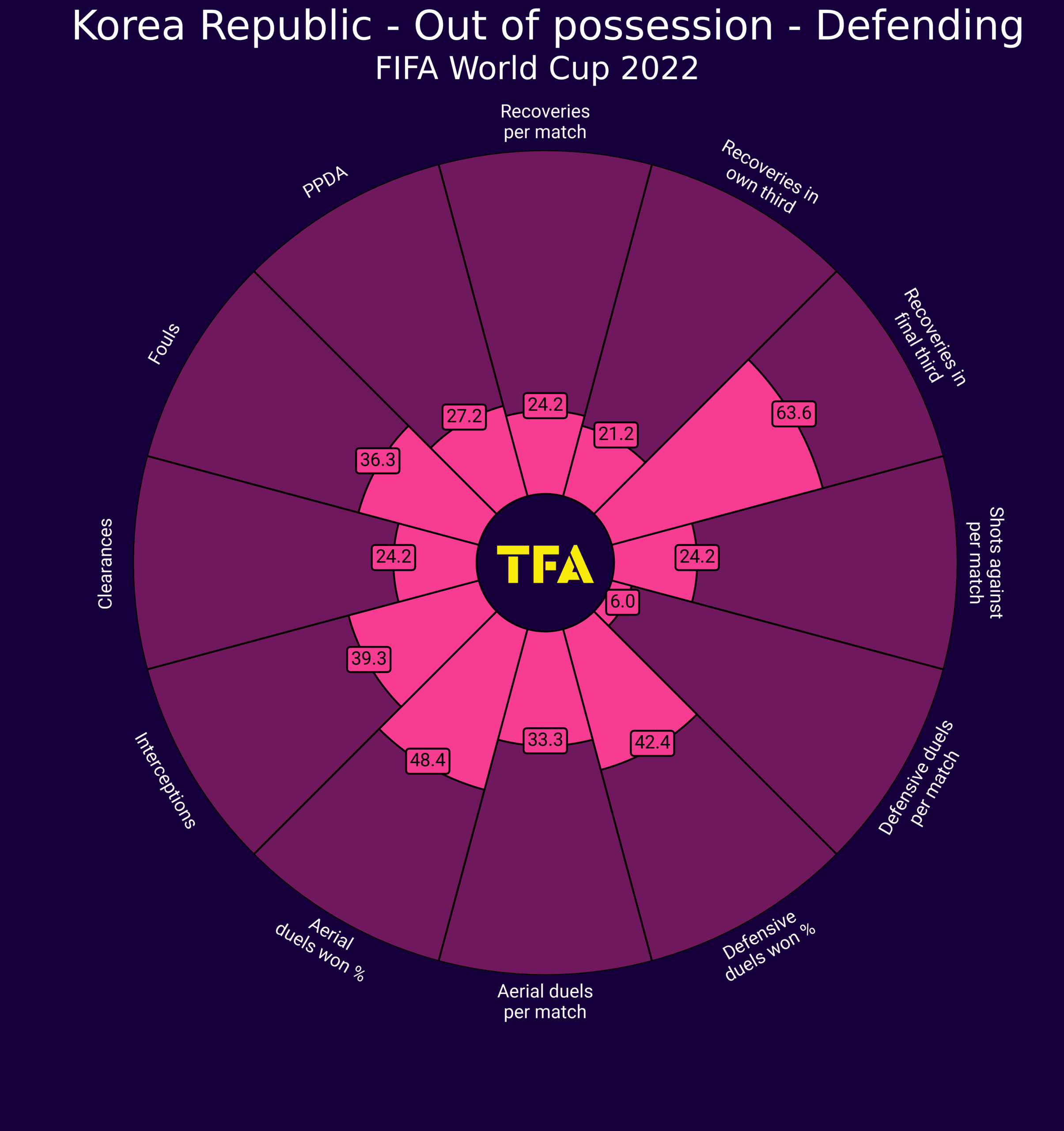
South Korea are an aggressive side without the ball, with promising numbers in terms of recovering area.
They have some physicality in the air, as their aerial duels per match percentile is 33.3, and the aerial duels won percentage, at the 48.4 percentile, was average.
In general, South Korea has a good ability to win the ball back in both high areas and around their third, as their recoveries in the final third percentile are quite high, at 63.6.
Their PPDA percentile at.
27.2 also suggests they are such a high-pressing side who like to play with intensity without possession.
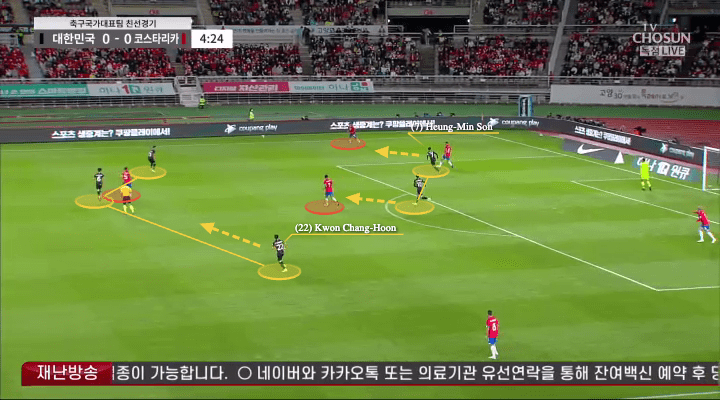
Without possession, South Korea are consistently in a 4-1-3-2 when pressing high, although we believe they will drop off to a 4-4-2 more in a midblock against stronger opponents.
But when they pushed, they gave good energy and did it with two strikers to pressure the ball, guide it to the outside, and close the opponents there.
In the first image, we saw Heung-min Son chasing the centre-backs. He invited the pass to the outside and kept pushing there, where Hee-chan Hwang also prepared himself to confront the defender as it happened.
In midfield, they always wanted to have a “pressing & cover” relationship between the holding midfielders, when one stepped up, the other often stayed behind the press shape to protect the second line or pick up the second balls.
Also, the far-side winger should come infield to maintain compactness, balancing the shape.
In this image, Chang-hoon Kwon moved in as the team was pressing on the other side so he would not be isolated and kept the three-man second line as a unit.
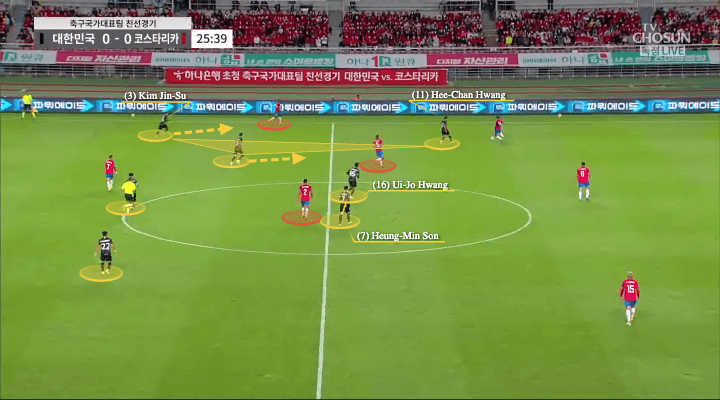
In the next image, we see South Korea defending in the midfield areas and pressing out wide using the same concepts.
Centrally, the pair of strikers – Heung-min Son and Ui-jo Hwang stayed tight to deny the opposition ‘6’ space, so the opponents did not play easy passes to escape in the centre.
Then, the example also demonstrated how South Korea compressed wide spaces, making it difficult for the opponents.
They were happy to commit the full-back (Jin-su Kim) and ball near ‘6’ to support the winger, who always saw the pass to outside as a trigger and jumped.
That was a three-man group to maintain a close unit, making sure that even if the opponent passed it forward vertically on the same side, the receiver could not easily get the turn to continue the attack.
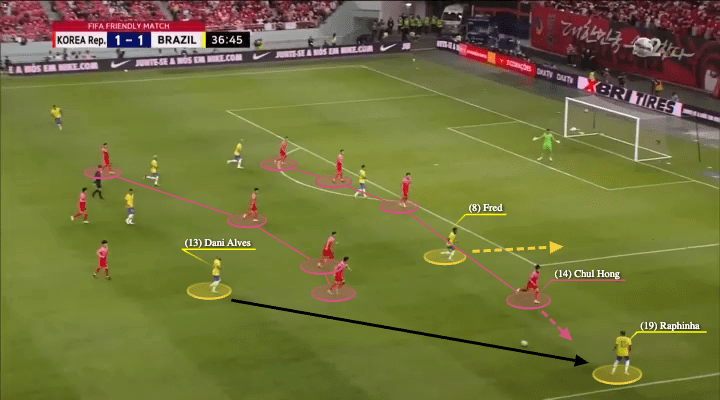
However, South Korea also had their weaknesses in their four-man last line.
The outside defender often got himself isolated after the opponents spread the ball to the wide space.
That pass very often invited the full-back to jump as Hong Chul did here.
However, when Hong Chul got closer to Raphinha, the left centre-back did not move with him and so Fred was totally free there.
One reason for that defensive behaviour was Bento’s side valued the proximity of the centre-backs more, so they did not want to concede any spaces to early crosses with the close positions of central defenders.
But that also resulted in the fullbacks getting exposed in 1v2 situations.
It would be hard to defend the next pass, the underlaps, overlaps, and crosses.
Given the weaknesses explained in the system, it will be intriguing to see if the South Korean winger drops deeper to protect wide spaces or if Bento will try a back five against stronger opponents in the World Cup.
South Korea Transitions
In offensive transitions, South Korea always looks to hit behind the last line as soon as possible to use the quality of its attackers, most of whom play in top European leagues.
For example, it would be very favourable if Heung-min Son is played into open spaces, charging towards the opponents as he does in the Premier League.
So, Bento’s side possesses counter-attacking threats.
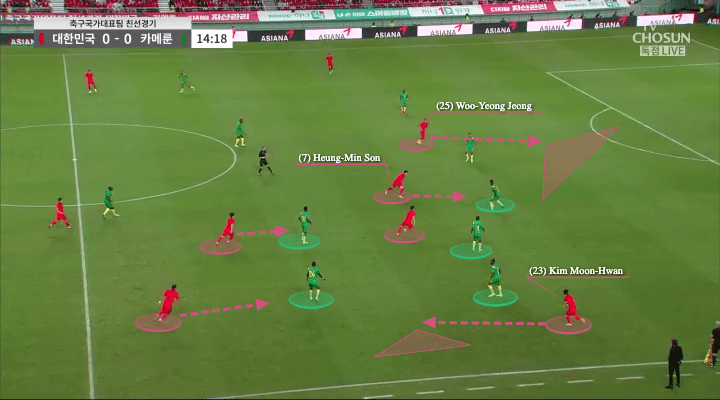
When it comes to defensive transitions (TAD), South Korea also like to counter-press and recapture the ball as soon as possible if they have the shape and numbers ready when attacking.
Because they attack from the flanks, they do not expose themselves centrally in TAD, so that was already a beneficial condition prematurely.
Then, you could see how they reacted against Cameroon once there was a turnover — central players who were behind the ball tried to push and close spaces, including the players in deep construction, so they should win every ball if the opponents played it short.
They also applied pressure instantly; the responsibility falls to the player in closest proximity to the ball, regardless of his name.
For example, Heung-min Son was also leading the counter-press in this image.
The two widest players outside of the counter-pressing shape were given different roles.
Instead of rushing towards the ball, they were more covering the press to net any ball potentially going outside of the counter-pressing group.
Apart from Moon-hwan Kim, who came back to cover, the striker’s (Woo-yeong Jeong) effort was also noticeable.
That player should always be ready to lurk and capture the backward passes to the goalkeeper if they happen.
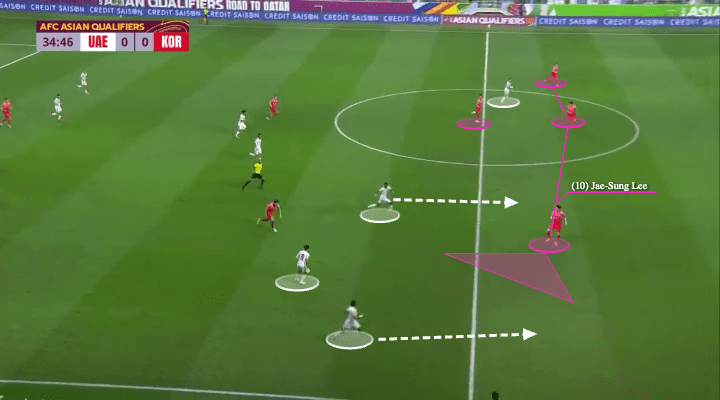
Based on how we explained their offensive organization earlier, South Korea almost had a 3-1 in terms of rest defence.
But that would be a problem when the full-backs push too high to attack the flanks, as they would concede spaces behind in that scenario.
For example, the UAE were able to develop a counter-attack from that weakness.
Once the ball was regained, they moved it outside and supported it with runners forward.
In that instance, Jae-sung Lee struggled in a 1v3 situation, confronting runners when dropping back.
Their opponents in the World Cup would also be looking for similar conditions to attack South Korea in the transitions.
South Korea Attackers
We all know Heung-min Son will be the most important player in the South Korean squad; the Tottenham Hotspur star has experienced some ups and downs in this campaign.
Although he scored a hat-trick versus Leicester City, that was his only Premier League game with goals, despite his 4.2 xG.
It will be crucial for this team whether Heung-min Son can get back to his best in time for the World Cup.
South Korea also has other attackers, such as Hee-chan Hwang from Wolves. However, the Wolves player has not started a Premier League game since August, and his form is in doubt.
They also have Ui-jo Hwang from Olympiacos, but the 30-year-old has yet to score a goal this season.
Like Heung-min Son, whether or not these players can pick up their game rhythm soon will be crucial.
South Korea Midfielders
In midfield, South Korea rely on the partnership of In-beom Hwang and Woo-yung Jung.
Both have been important players in their respective teams – Olympiacos and Al Saad.
The former has recorded a very high xA/90 as a midfielder so far at 0.22, and he has given 21.99 forward passes/90, showing that he is a player with the mindset to break lines and play the ball forward.
Juanma Lillo also trusted Woo-yung Jung in his midfield; he has decent ability to recover possession with 9.19 recoveries/90, and 4.21 interceptions/90.
He also has a progressive mindset and similar forward passes/90 stats to his midfield partner, at 21.06/90.
South Korea will rely on the duo to send the ball forward.
South Korea Defenders
South Korea’s defence is mainly formed by players in K-League 1, such as Hong Chul and Moon-hwan Kim, but this season, Min-jae Kim impressed the whole of Europe with his sharp performances at Napoli.
He has a very decent recoveries/90 stat at 12.96 and is competitive in the air with 6.02 aerial duels/90 and a success rate of 59.3%.
Min-jae Kim is also comfortable on the ball with 25 forward passes/90, his involvement in the build-up will help South Korea to move the ball forward.
South Korea Key player
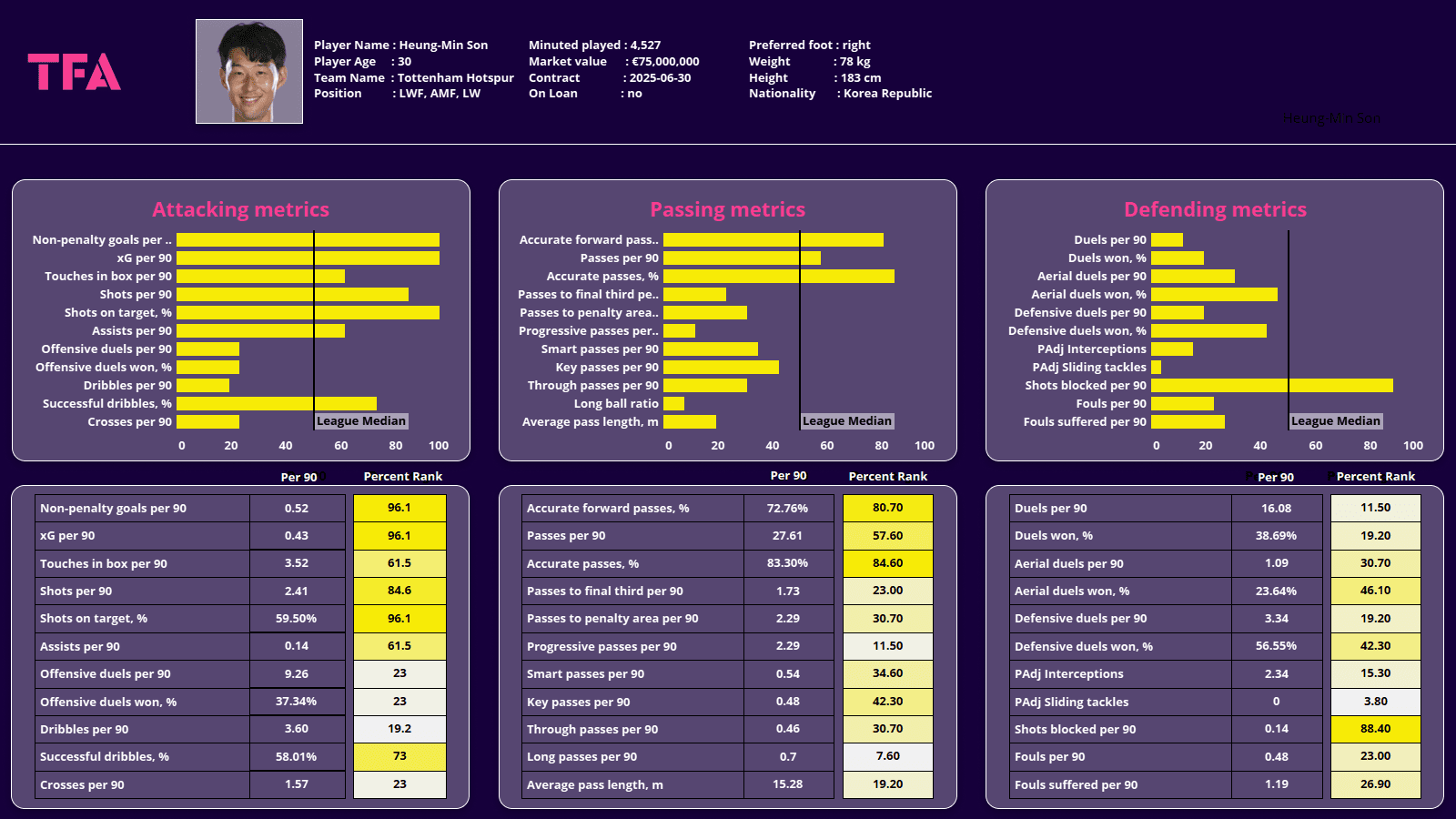
We had to pick Heung-min Son as the one to watch in the South Korean team, regardless of who else made the squad.
The 30-year-old attacking player was Asia’s pride when he won the Premier League Golden Boot last season alongside Mohamed Salah.
Individually, he is a very good player and plays an important role in Bento’s side.
We expect Heung-min to be the main source of threat, or even something more wonderful given what he showed us in the Premier League.
The team can rely on his quality during offensive transitions because Heung-min Son can take on and beat defenders in open spaces.
Defensively, he will not be jogging and relaxing.
Instead, as the team’s captain, Heung-min Son will set a good example for the rest by leading the press or executing defensive responsibilities.
If he shines in key moments, South Korea will definitely have a better chance to qualify for the group stage, which would be the dream of their supporters.
South Korea Tournament prediction
Although Uruguay and Portugal should be the favourites to qualify from the group stage, we should not overlook South Korea’s chances either because they have a motivated and committed squad with good quality.
They also have plenty of players in their prime with good experience in European football.
The last time they made it into the last 16 was in 2010, and in their last six World Cup matches, South Korea have only achieved one win.
Nevertheless, we believe they should at least add another one to the tally in Qatar.
If they manage to resist the favourites, there could be surprises.

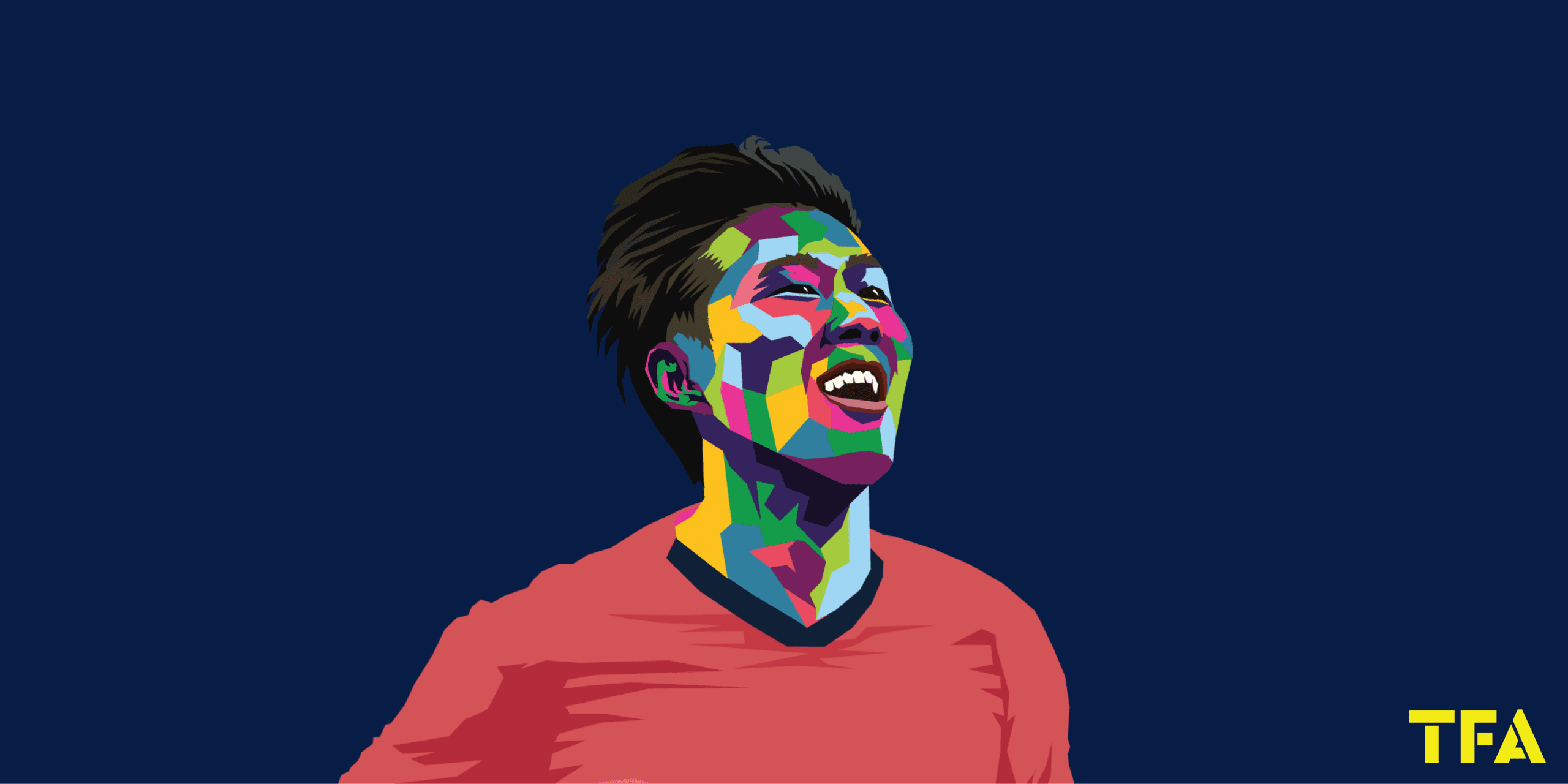



Comments